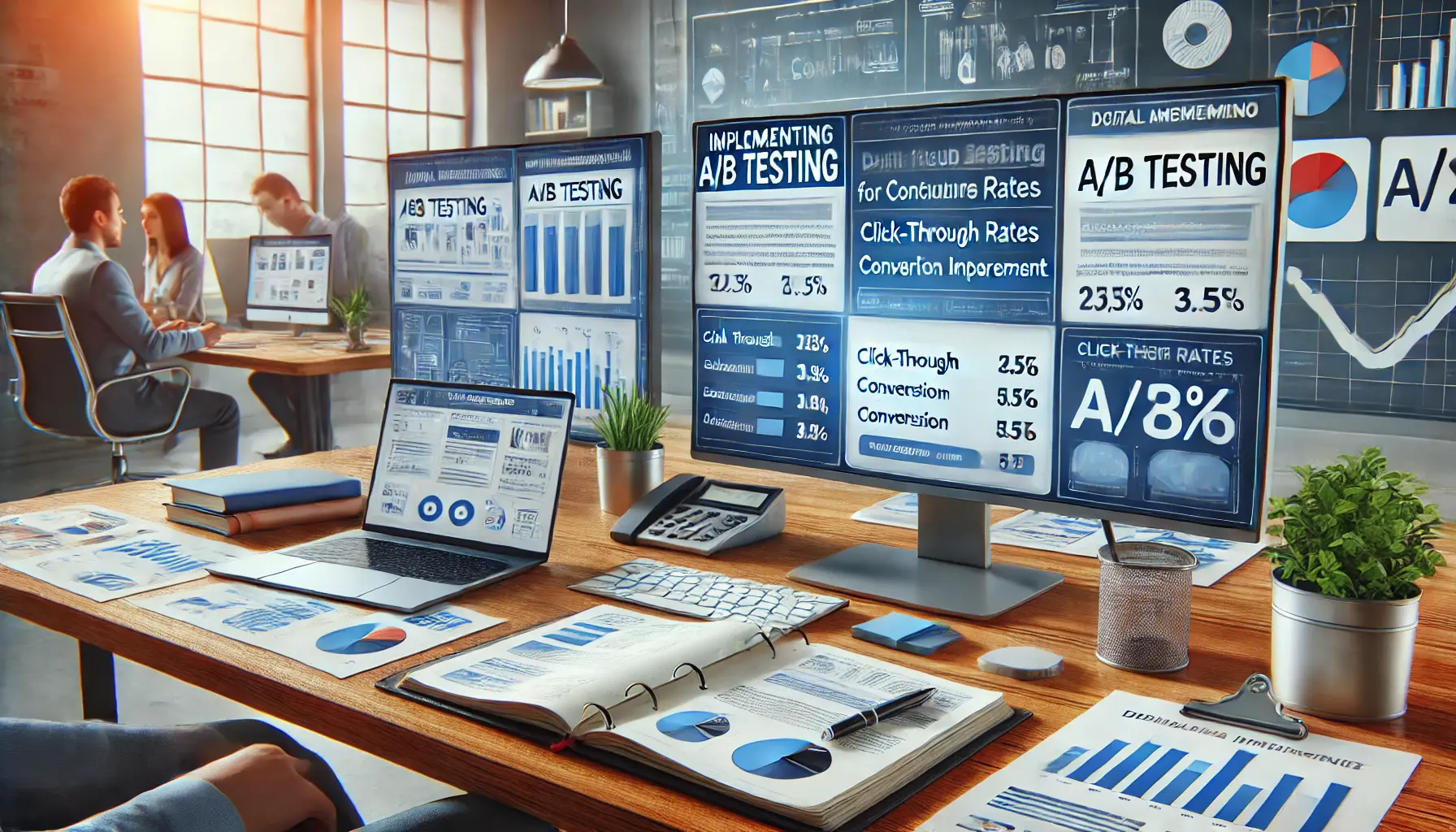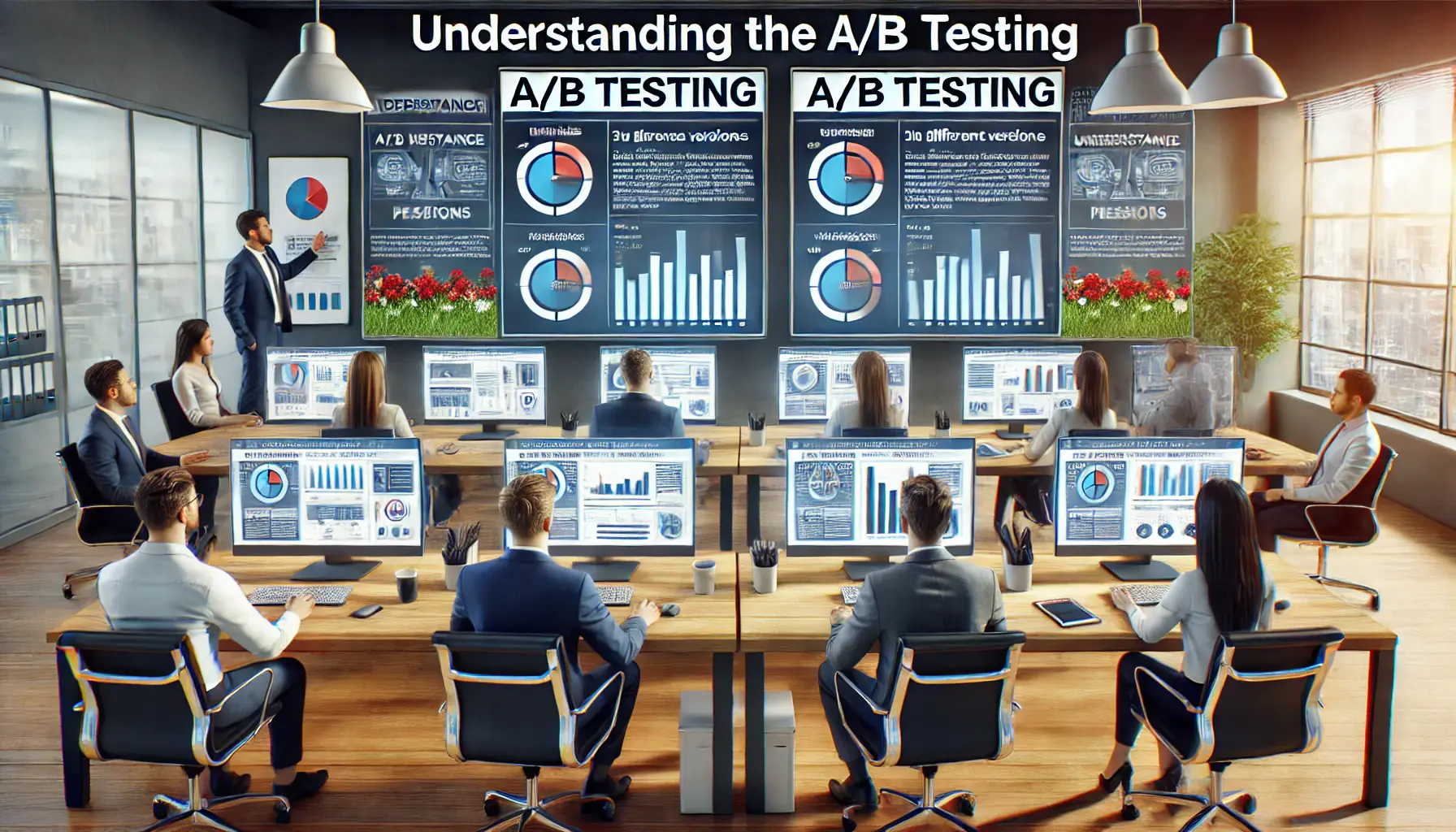Display advertising remains a cornerstone in the ever-evolving landscape of digital marketing for businesses that want to capture audience attention and drive conversions.
But mere ad placements across the web are not sufficient.
To actually tap into the power of display ads, effective conversion optimization strategies need to be put in place.
This article delves into five proven methods to enhance the performance of your display advertising campaigns, ensuring you not only reach your target audience but also encourage them to take meaningful actions.
- Understanding Conversion Optimization in Display Advertising
- Crafting Compelling Ad Creatives
- Targeting the Right Audience
- Optimizing Landing Pages for Better Conversions
- Implementing A/B Testing for Continuous Improvement
- How to Master Conversion Optimization in Display Advertising
- Conversion Optimization in Display Advertising: Frequently Asked Questions
Understanding Conversion Optimization in Display Advertising
Before diving into specific strategies, it’s crucial to grasp what conversion optimization entails within the realm of display advertising.
At its core, conversion optimization focuses on increasing the percentage of users who take a desired action after interacting with your ad—be it making a purchase, signing up for a newsletter, or downloading a resource.

Illustration of tools and processes for defining and analyzing conversion optimization.
Defining Conversion Optimization
Conversion optimization is the systematic process of enhancing your display ads and associated landing pages to boost the likelihood of visitors completing a specific goal.
This involves analyzing user behavior, testing various ad elements, and refining your approach based on data-driven insights.

Illustration of the importance of conversion optimization in display advertising, showing key performance metrics.
Importance of Conversion Optimization in Display Ads
Why should you prioritize conversion optimization?
Simply put, it maximizes the return on your advertising investment.
By fine-tuning your ads to resonate with your audience, you can achieve higher engagement rates without necessarily increasing your ad spend.
This efficiency is vital in a competitive digital marketplace.

An illustration showcasing key metrics for monitoring success in digital advertising campaigns.
Key Metrics to Monitor for Success
To gauge the effectiveness of your conversion optimization efforts, keep a close eye on the following metrics:
- Click-Through Rate (CTR): Measures the percentage of users who click on your ad after viewing it. A high CTR indicates that your ad is appealing and relevant.
- Conversion Rate: The percentage of users who execute the intended action once they have clicked your ad. This is the direct outcome of optimization techniques.
- Cost Per Conversion: Calculates the average money spent to generate one conversion. Lowering this cost signifies more efficient use of your advertising budget.
- Return on Ad Spend (ROAS): Assesses the revenue generated for every dollar spent on advertising. A higher ROAS indicates a more profitable campaign.
By consistently monitoring these metrics, you can identify areas for improvement and make informed decisions to enhance your display advertising performance.
Conversion optimization ensures your display ads remain efficient and impactful in reaching your business goals.
Conversion optimization in display advertising ensures that every ad dollar spent is maximized for impact, driving actions that align with your business goals.

Illustration of the process of designing compelling ad creatives for digital marketing.
Crafting Compelling Ad Creatives
In the realm of display advertising, the creative elements of your ads play a pivotal role in capturing attention and driving conversions.
Effective conversion optimization hinges on the ability to design ads that not only attract but also engage your target audience.
Let’s explore the key components that contribute to compelling ad creatives.

Illustration of the process of designing visually appealing ads for digital marketing.
Designing Visually Appealing Ads
Visual appeal is the first impression your ad makes.
In consideration of conversion optimization, here are some design principles to consider:
- Clarity and Simplicity: Employ clean layouts with ample white space so as not to overwhelm the viewer.
- High-Quality Images: Incorporate sharp, relevant images that appeal to your target audience.
- Consistent Branding: Ensure colors, fonts, and imagery align with your brand identity.
- Responsive Design: Optimize ads for various devices to maintain visual integrity across platforms.
By adhering to these design principles, you create ads that are not only aesthetically pleasing but also conducive to higher engagement rates, thereby supporting your conversion optimization efforts.

Illustration of a copywriter engaged in writing persuasive ad copy in a modern workspace.
Writing Persuasive Ad Copy
The words are equally as important as the images.
Ad copy has been known to make a great difference when it comes to conversion optimization.
Here are some tactics to consider:
- Value Proposition: Define exactly what value your product or service offers.
- Concise Messaging: Use brief, compelling sentences to effectively communicate your key message.
- Emotional Connection: Appeal to emotions that connect users to your brand story.
- Scarcity and Urgency: Employ time-limited offers to motivate people to take action sooner rather than later.
By crafting compelling ad copy that speaks directly to your audience’s needs and desires, the probability of conversions increases, thereby strengthening your conversion optimization approach.

Illustration of a designer focusing on applying efficient calls-to-action in digital advertising.
Applying Efficient Calls-to-Action
The call-to-action, or CTA, is the powerhouse behind conversion optimization.
To implement efficient calls-to-action:
- Use Action-Oriented Language: Employ action verbs like ‘Discover,’ ‘Get,’ or ‘Start’ to encourage people to act immediately.
- Create a Sense of Urgency: Phrases like ‘Limited Time Offer’ or ‘Act Now’ can trigger quick responses.
- Ensure Visibility: Design CTAs that stand out through contrasting colors and strategic placement.
- Match with Landing Pages: Make sure the CTA directs traffic to a landing page that delivers on what was promoted in the ad.
By paying attention to these components, you can create ad creatives that drive not just awareness but real, meaningful actions, furthering your conversion optimization efforts.
High-quality visuals and persuasive ad copy are the pillars of compelling ad creatives, which directly influence conversion rates.

Illustration of the process of targeting the right audience in digital advertising.
Targeting the Right Audience
In display advertising, reaching the appropriate audience is crucial for effective conversion optimization.
By focusing your efforts on individuals most likely to engage with your ads, you can enhance engagement and drive meaningful actions.
Let’s explore strategies to identify and connect with your ideal audience.

Illustration of a digital marketing team utilizing demographic and behavioral data for targeted advertising.
Utilizing Demographic and Behavioral Data
Understanding your audience’s demographics and behaviors is fundamental to conversion optimization.
Consider the following approaches:
- Demographic Targeting: Identify key characteristics such as age, gender, income level, and education to tailor your ads accordingly.
- Behavioral Targeting: Analyze online behaviors, including browsing history and past purchases, to predict future actions and preferences.
By leveraging this data, you can create personalized ads that resonate with your audience, thereby improving conversion optimization.

Illustration of leveraging retargeting techniques in digital advertising to engage previous website visitors.
Leveraging Retargeting Techniques
Retargeting provides the opportunity to re-engage users who previously interacted with your website or ads, turning them into potential conversions.
Effective strategies include:
- Site Retargeting: Show ads to users who visited your site but did not convert, reminding them of your offerings.
- Email Retargeting: Send personalized emails to users who abandoned shopping carts, encouraging them to complete their purchase.
Implementing these techniques keeps your brand top-of-mind and encourages users to return and convert, supporting your conversion optimization goals.

Illustration of a team employing contextual targeting strategies in digital advertising by analyzing content for ad placement.
Employing Contextual Targeting Strategies
Contextual targeting involves placing your ads on websites or pages that are relevant to your product or service, thereby enhancing conversion optimization.
To implement this strategy:
- Keyword Targeting: Select keywords related to your offerings to ensure your ads appear alongside pertinent content.
- Topic Targeting: Target specific topics or categories that relate to your product to reach interested audiences.
By aligning your ads with related content, you are more likely to engage users already interested in your industry, which enhances conversion optimization.
By effectively targeting the right audience through these strategies, not only does engagement thrive, but conversion optimization also sees a significant boost, resulting in more effective display advertising campaigns.
Without precise audience targeting, even the most well-crafted ads may fail to yield conversions, underscoring the importance of leveraging demographic and behavioral data.

Illustration of the process of optimizing landing pages for improved conversions in digital advertising.
Optimizing Landing Pages for Better Conversions
Once a user clicks on your display ad, the landing page they arrive at plays a pivotal role in determining whether they will convert.
Effective conversion optimization requires that your landing pages are meticulously designed to meet user expectations and encourage desired actions.
Let’s explore key strategies to enhance your landing pages for better conversions.

Illustration of the process of ensuring message match between ads and landing pages in digital advertising.
Ensuring Message Match Between Ads and Landing Pages
The message of your ad and the content of the landing page must align for effective conversion optimization.
Users clicking on an ad want to see information relevant to what was promised.
To do this:
- Align Headlines: Use similar or identical headlines on both the ad and landing page to reinforce the message.
- Maintain Visual Consistency: Ensure colors, fonts, and images are consistent between the ad and the landing page.
- Deliver on Promises: Highlight discounts or special deals prominently on the landing page if they were offered in the ad.
By ensuring a strong message match, you build trust among users, reduce bounce rates, and enhance conversion optimization.

Illustration of the process of designing user-friendly and responsive layouts for a seamless user experience across devices.
Designing User-Friendly and Responsive Layouts
A well-designed landing page that offers a seamless user experience is vital for optimizing conversions.
Consider the following design principles:
- Clear Call-to-Action (CTA): Place a visible and compelling CTA button that directs users to take a specific action.
- Minimalist Design: Avoid clutter by using sufficient white space and emphasizing elements that drive conversions.
- Mobile Optimization: Ensure the landing page is responsive and functions smoothly across all devices, especially smartphones.
- Fast Loading Speeds: Optimize images and code to reduce loading times, as delays can lead to higher bounce rates.
Implementing these design strategies creates a user-friendly environment that encourages visitors to stay and convert, improving conversion optimization.

Illustration of incorporating trust signals and social proof in digital advertising to build credibility.
Incorporating Trust Signals and Social Proof
Building trust on your landing page is essential for conversion optimization.
The more trust users have in your brand, the better the chance they will convert.
To establish trust:
- Testimonials: Display positive feedback from satisfied customers to showcase your product’s value.
- Certifications: Highlight industry certifications and awards that enhance your credibility.
- Trust Badges: Include security badges if you’re collecting personal information or processing payments.
- Provide Contact Information: Make clear and accessible contact details available to assure users they can reach you if needed.
By adding these trust signals, you alleviate potential concerns, making users more comfortable to proceed, thus enhancing conversion optimization.
Optimizing your landing pages with these strategies ensures that when users click through your display ads, they are greeted with a seamless, trustworthy, and persuasive experience, significantly boosting your conversion optimization efforts.
A well-optimized landing page acts as a bridge between user interest and action, making alignment with ad promises critical for success.

Illustration of implementing A/B testing in digital advertising to improve performance through data analysis.
Implementing A/B Testing for Continuous Improvement
In the dynamic world of display advertising, continuous refinement is essential for effective conversion optimization.
A/B testing, also known as split testing, serves as a powerful method to compare different versions of your ads or landing pages to determine which performs better.
By systematically testing variations, you can make data-driven decisions that enhance your campaign’s effectiveness.

Illustration of the A/B testing process in digital marketing, comparing different ad versions to optimize performance.
Understanding the A/B Testing Process
A/B testing involves creating two versions of an element—such as an ad creative or a landing page—and randomly distributing them across your audience to determine which one works better.
The process includes:
- Identifying Variables: Choose specific elements to test, including headlines, images, and call-to-action buttons.
- Creating Variations: Develop alternate versions of the chosen elements while keeping other factors constant.
- Random Distribution: Present each version to a randomly selected portion of your audience to achieve unbiased results.
- Analyzing Results: Gather and compare performance data to determine which version works better.
This straightforward process helps you pinpoint the elements that have the greatest impact on your conversion optimization.

Illustration of testing key elements in display ads for digital marketing optimization.
Key Elements to Test in Display Ads
For the highest return with A/B testingA method of comparing two versions of an element to determine which performs better. in display advertising, consider experimenting with the following components:
- Headline: Try different headlines to determine which garners the most interest and engagement.
- Visuals: Experiment with various images or graphics to identify those that resonate best with your target audience.
- Call-to-Action (CTA): Test different phrasing, button colors, and placements to find the most compelling combination.
- Ad Creative Formats: Assess the performance of different ad formats, such as static images versus animated banners.
By systematically testing these elements, you can uncover valuable insights that lead to more effective ads and improved conversion optimization.

Illustration of best practices for A/B testing in digital advertising, focusing on analyzing performance metrics.
Best Practices for Effective A/B Testing
To ensure your A/B tests provide constructive insights for conversion optimization, follow these best practices:
- Test One Variable at a Time: Isolate individual elements to accurately attribute performance changes to specific modifications.
- Ensure Statistical Significance: Run tests with a large enough sample size and duration to achieve reliable results.
- Maintain Consistency: Keep external factors constant during the testing period to avoid skewing the data.
- Document and Analyze: Record all test parameters and outcomes to inform future conversion optimization strategies.
By adhering to these best practices, you can conduct A/B tests that yield actionable insights, enabling continuous improvement in your display advertising campaigns.
A/B testing allows you to integrate marketing intuition with empirical data to make informed decisions, driving ongoing enhancements in conversion optimization and overall campaign performance.
A/B testing reveals actionable insights that drive iterative improvements, ensuring your campaigns stay competitive and relevant.

Illustration of mastering conversion optimization in display advertising through data analysis and strategic discussions.
How to Master Conversion Optimization in Display Advertising
Display advertising holds immense potential for businesses in pursuit of capturing attention and driving meaningful actions.
However, its true power lies in implementing effective conversion optimization strategies.
By integrating all the key principles shared throughout this article, you will be able to shape your campaigns into ultra-high-performance, conversion-focused endeavors.

Illustration of key takeaways from digital marketing strategies, with a team focused on analyzing data to improve results.
Key Takeaways from the Strategies
Here’s a quick recap of the main strategies to optimize your display advertising campaigns for better performance:
- Understand Conversion Optimization: Grasp the importance of metrics such as CTR, conversion rate, and ROAS to effectively measure success.
- Create Compelling Ad Creatives: Use visually appealing designs, persuasive ad copy, and strong calls-to-action to engage your audience.
- Target the Right Audience: Leverage demographic and behavioral data, retargeting techniques, and contextual targeting to reach those most likely to convert.
- Optimize Landing Pages: Ensure message match, user-friendly design, and trust signals to provide a seamless experience that encourages conversions.
- Use A/B Testing: Continuously refine your campaigns by testing and analyzing variations to uncover what works best for your audience.

Illustration of a digital marketing team analyzing data to demonstrate why conversion optimization matters in digital advertising.
Why Conversion Optimization Matters
Conversion optimization is more than a strategy—it’s a commitment to improving every touchpoint in your advertising journey.
By focusing on conversion optimization, you not only increase engagement but also ensure every dollar spent on advertising yields maximum value.
It’s about creating a win-win situation for both your business and your audience, where ads provide genuine value and encourage desired actions.

Illustration of a digital marketing team beginning their optimization journey to improve ad performance.
Start Your Optimization Journey Today
The world of display advertising is constantly evolving, yet the core principles behind conversion optimization remain consistent.
Whether starting new campaigns or seeking improvement, applying these strategies will help you achieve measurable and sustainable results.
Start by assessing your current campaigns, identifying areas for improvement, and implementing the techniques discussed here.
With dedication and data-driven decisions, you can master conversion optimization, ensuring your display ads not only capture attention but also drive meaningful results for your business.
Mastering conversion optimization requires consistent efforts across all campaign elements, from ad creatives to landing pages, backed by data-driven strategies.

undefined
Your campaigns can be managed by an agency specialized in Google Ads, check out our service page.
Conversion Optimization in Display Advertising: Frequently Asked Questions
Conversion optimization in display advertising is essential for improving campaign performance.
Below are common questions and concise answers to guide you in optimizing your display ads effectively.
Conversion optimization in display advertising involves refining ads and landing pages to increase the percentage of users who complete a desired action, such as making a purchase or signing up for a newsletter.
It maximizes the return on investment by improving ad relevance and effectiveness, leading to higher engagement and more conversions without necessarily increasing ad spend.
Design visually appealing ads with clear messaging, use high-quality images, and include strong calls-to-action that resonate with your target audience to encourage engagement.
Utilize demographic and behavioral data, implement retargetingA digital marketing technique that re-engages users who previously interacted with a website or ad. techniques, and employ contextual targetingAn advertising strategy that places ads on web pages with content relevant to the product or service being advertised. to reach users most likely to convert.
Ensure consistency between ad messages and landing page content, design user-friendly layouts, and incorporate trust signals like testimonials and security badges to build credibility.
A/B testing compares two versions of an ad or landing page to determine which performs better, allowing for data-driven decisions to enhance conversion rates.
Regularly conduct A/B testing, especially when implementing new strategies or noticing changes in user behavior, to continuously improve ad performance.
Key metrics include click-through rate (CTR), conversion rateThe percentage of users who complete the desired action after interacting with an ad., cost per conversionThe average cost incurred to achieve a single conversion., and return on ad spendA metric that measures the revenue earned for every dollar spent on advertising. (ROAS), which collectively assess the effectiveness of your campaigns.
Absolutely.
Conversion optimization helps small businesses maximize their advertising budget by improving ad efficiency and increasing the likelihood of user conversions.













